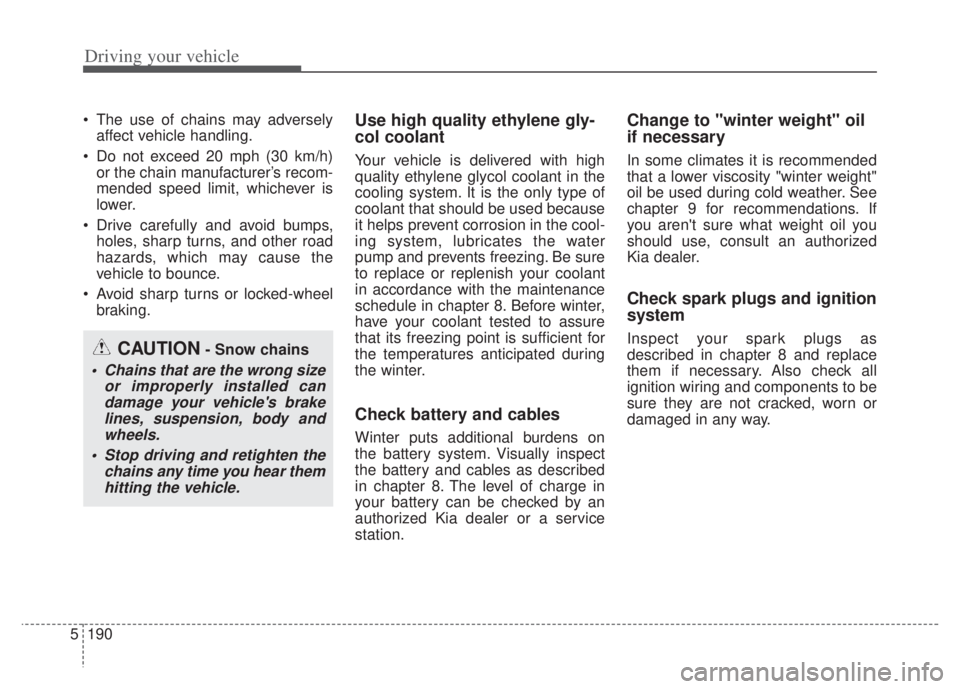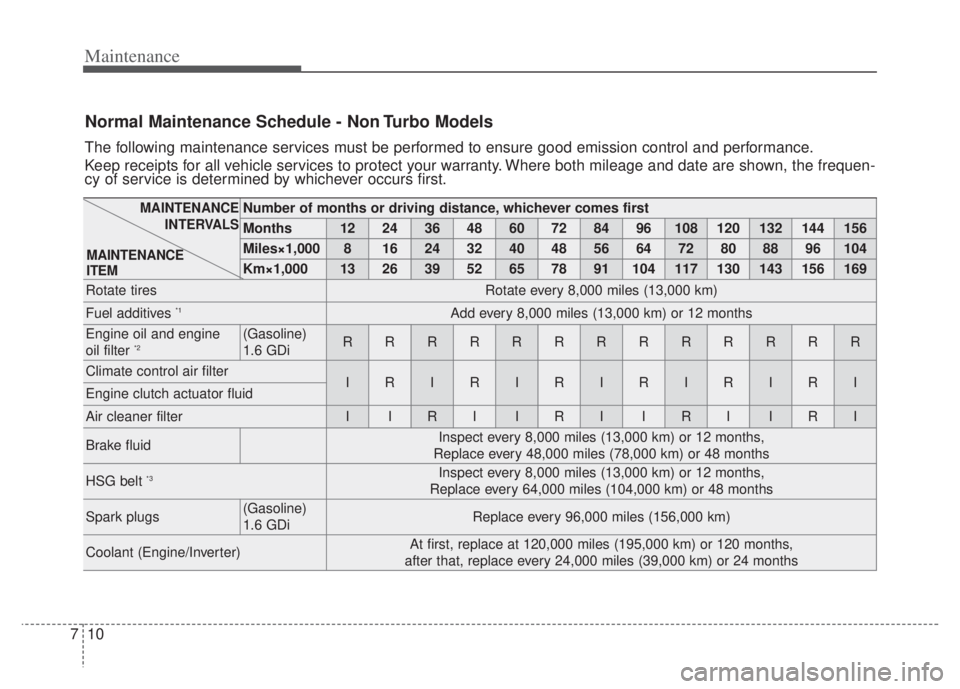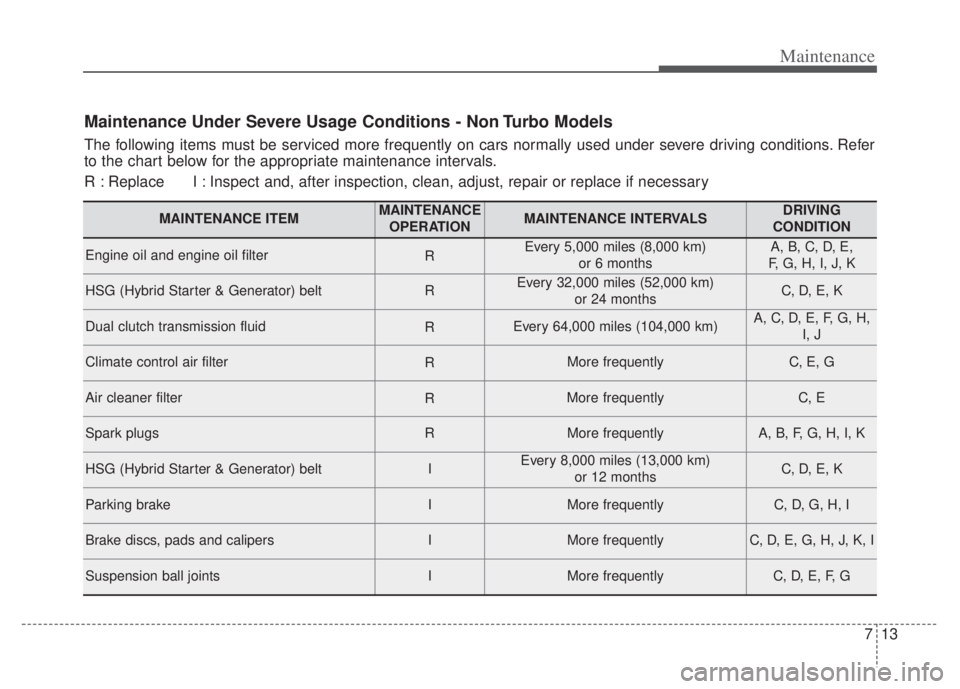spark plugs replace KIA NIRO PHEV 2022 Owners Manual
[x] Cancel search | Manufacturer: KIA, Model Year: 2022, Model line: NIRO PHEV, Model: KIA NIRO PHEV 2022Pages: 710, PDF Size: 10.35 MB
Page 513 of 710

Driving your vehicle
190
5
The use of chains may adversely
affect vehicle handling.
Do not exceed 20 mph (30 km/h) or the chain manufacturer’s recom-
mended speed limit, whichever is
lower.
Drive carefully and avoid bumps, holes, sharp turns, and other road
hazards, which may cause the
vehicle to bounce.
Avoid sharp turns or locked-wheel braking.Use high quality ethylene gly-
col coolant
Your vehicle is delivered with high
quality ethylene glycol coolant in the
cooling system. It is the only type of
coolant that should be used because
it helps prevent corrosion in the cool-
ing system, lubricates the water
pump and prevents freezing. Be sure
to replace or replenish your coolant
in accordance with the maintenance
schedule in chapter 8. Before winter,
have your coolant tested to assure
that its freezing point is sufficient for
the temperatures anticipated during
the winter.
Check battery and cables
Winter puts additional burdens on
the battery system. Visually inspect
the battery and cables as described
in chapter 8. The level of charge in
your battery can be checked by an
authorized Kia dealer or a service
station.
Change to "winter weight" oil
if necessary
In some climates it is recommended
that a lower viscosity "winter weight"
oil be used during cold weather. See
chapter 9 for recommendations. If
you aren't sure what weight oil you
should use, consult an authorized
Kia dealer.
Check spark plugs and ignition
system
Inspect your spark plugs as
described in chapter 8 and replace
them if necessary. Also check all
ignition wiring and components to be
sure they are not cracked, worn or
damaged in any way.CAUTION- Snow chains
Chains that are the wrong size or improperly installed candamage your vehicle's brakelines, suspension, body andwheels.
Stop driving and retighten the chains any time you hear themhitting the vehicle.
Page 573 of 710

Maintenance
10
7
Normal Maintenance Schedule - Non Turbo Models
The following maintenance services must be performed to ensure good emission control and performance.
Keep receipts for all vehicle services to protect your warranty. Where both mileage and date are shown, the frequen-
cy of service is determined by whichever occurs first.
Number of months or driving distance, whichever comes first
Months1224364860728496108120132144156
Miles×1,00081624324048566472808896104
Km×1,00013263952657891104117130143156169
Rotate tiresRotate every 8,000 miles (13,000 km)
Fuel additives *1Add every 8,000 miles (13,000 km) or 12 months
Engine oil and engine
oil filter *2(Gasoline)
1.6 GDiRRRRRRRRRRRRR
Climate control air filterIRIRIRIRIRIRIEngine clutch actuator fluid
Air cleaner filterIIRIIRIIRIIRI
Brake fluidInspect every 8,000 miles (13,000 km) or 12 months,
Replace every 48,000 miles (78,000 km) or 48 months
HSG belt *3Inspect every 8,000 miles (13,000 km) or 12 months,
Replace every 64,000 miles (104,000 km) or 48 months
Spark plugs(Gasoline)
1.6 GDiReplace every 96,000 miles (156,000 km)
Coolant (Engine/Inverter)At first, replace at 120,000 miles (195,000 km) or 120 months,
after that, replace every 24,000 miles (39,000 km) or 24 months
MAINTENANCE INTERVALS
MAINTENANCE
ITEM
Page 576 of 710

713
Maintenance
Maintenance Under Severe Usage Conditions - Non Turbo Models
The following items must be serviced more frequently on cars normally used under severe driving conditions. Refer
to the chart below for the appropriate maintenance intervals.
R : Replace I : Inspect and, after inspection, clean, adjust, repair or replace if neces\
sary
MAINTENANCE ITEMMAINTENANCEOPERATIONMAINTENANCE INTERVALSDRIVING
CONDITION
Engine oil and engine oil filterREvery 5,000 miles (8,000 km) or 6 monthsA, B, C, D, E,
F, G, H, I, J, K
HSG (Hybrid Starter & Generator) beltREvery 32,000 miles (52,000 km) or 24 monthsC, D, E, K
Dual clutch transmission fluidREvery 64,000 miles (104,000 km)A, C, D, E, F, G, H,I, J
Climate control air filterRMore frequentlyC, E, G
Air cleaner filterRMore frequentlyC, E
Spark plugsRMore frequentlyA, B, F, G, H, I, K
HSG (Hybrid Starter & Generator) beltIEvery 8,000 miles (13,000 km) or 12 monthsC, D, E, K
Parking brakeIMore frequentlyC, D, G, H, I
Brake discs, pads and calipersIMore frequentlyC, D, E, G, H, J, K, I
Suspension ball jointsIMore frequentlyC, D, E, F, G
Page 579 of 710

Maintenance
16
7
Vacuum crankcase ventilation
hoses
Inspect the surface of hoses for evi-
dence of heat and/or mechanical
damage. Hard and brittle rubber,
cracking, tears, cuts, abrasions, and
excessive swelling indicate deterio-
ration. Particular attention should be
paid to examine those hose surfaces
nearest to high heat sources, such
as the exhaust manifold.
Inspect the hose routing to assure
that the hoses do not come in con-
tact with any heat source, sharp
edges or moving component which
might cause heat damage or
mechanical wear. Inspect all hose
connections, such as clamps and
couplings, to make sure they are
secure, and that no leaks are pres-
ent. Hoses should be replaced
immediately if there is any evidence
of deterioration or damage.
Air cleaner filter
A Genuine Kia air cleaner filter is
recommended when the filter is
replaced.
Spark plugs
Make sure to install new spark plugs
of the correct heat range.
When assembling parts, be sure to
wipe the inside and outside of the
boot bottom of the ignition coil and
the insulator of the spark plug with a
soft cloth to prevent contamination of
the spark plug insulator.
Cooling system
Check the cooling system compo-
nents, such as the radiator, coolant
reservoir, hoses and connections for
leakage and damage. Replace any
damaged parts.
Coolant (Engine / Inverter)
The coolant should be changed at
the intervals specified in the mainte-
nance schedule.
Dual clutch transmission Fluid
Inspect the dual clutch transmission
fluid according to the maintenance
schedule.
Brake hoses and lines
Visually check for proper installation,
chafing, cracks, deterioration and
any leakage. Replace any deteriorat-
ed or damaged parts immediately.
Page 709 of 710

I11
Index
Vehicle break-in process . . . . . . . . . . . . . . . . . . . . . . . . . 1-5
Vehicle certification label . . . . . . . . . . . . . . . . . . . . . . . 8-11
Vehicle data collection and event data recorders . . . . . . 1-6
Vehicle identification number (VIN) . . . . . . . . . . . . . . 8-10
Vehicle load limit . . . . . . . . . . . . . . . . . . . . . . . . . . . . 5-192Certification label . . . . . . . . . . . . . . . . . . . . . . . . . . 5-195
Tire and loading information label. . . . . . . . . . . . . 5-192
Vehicle modifications . . . . . . . . . . . . . . . . . . . . . . . . . . . 1-5
Vehicle weight . . . . . . . . . . . . . . . . . . . . . . . . . . . . . . 5-196 Base curb weight . . . . . . . . . . . . . . . . . . . . . . . . . . 5-196
Cargo weight . . . . . . . . . . . . . . . . . . . . . . . . . . . . . 5-196
GAW (Gross axle weight) . . . . . . . . . . . . . . . . . . . 5-196
GAWR (Gross axle weight rating) . . . . . . . . . . . . . 5-196
GVW (Gross vehicle weight). . . . . . . . . . . . . . . . . 5-196
GVWR (Gross vehicle weight rating) . . . . . . . . . . 5-196
Vehicle curb weight . . . . . . . . . . . . . . . . . . . . . . . . 5-196
Warning and indicator lights. . . . . . . . . . . . . . . . . . . . 4-106 Indicator Lights . . . . . . . . . . . . . . . . . . . . . . . . . . . 4-115
Warning lights . . . . . . . . . . . . . . . . . . . . . . . . . . . . 4-106
Checking the washer fluid level . . . . . . . . . . . . . . . . 7-31
Washer fluid . . . . . . . . . . . . . . . . . . . . . . . . . . . . . . . . . 7-31
Welcome system . . . . . . . . . . . . . . . . . . . . . . . . . . . . . 4-139 Headlight (Headlamp) escort function . . . . . . . . . . 4-139 Interior light . . . . . . . . . . . . . . . . . . . . . . . . . . . . . 4-139
Pocket lamp . . . . . . . . . . . . . . . . . . . . . . . . . . . . . . 4-139
Windows . . . . . . . . . . . . . . . . . . . . . . . . . . . . . . . . . . . . \
4-31 Power windows . . . . . . . . . . . . . . . . . . . . . . . . . . . . 4-32
Windshield defrosting and defogging. . . . . . . . . . . . . 4-157 Automatic climate control system . . . . . . . . . . . . . 4-157
Defogging logic . . . . . . . . . . . . . . . . . . . . . . . . . . . 4-158
Winter driving . . . . . . . . . . . . . . . . . . . . . . . . . . . . . . . 5-188 Carry emergency equipment . . . . . . . . . . . . . . . . . 5-191
Change to "winter weight" oil if necessary . . . . . . 5-190
Check battery and cables . . . . . . . . . . . . . . . . . . . . 5-190
Check spark plugs and ignition system . . . . . . . . . 5-190
Don’t let your parking brake freeze . . . . . . . . . . . . 5-191
Don't let ice and snow accumulate underneath . . . 5-191
Snowy or icy conditions . . . . . . . . . . . . . . . . . . . . . 5-188
To keep locks from freezing. . . . . . . . . . . . . . . . . . 5-191
Use approved window washer anti-freeze in system . 5-191
Use high quality ethylene glycol coolant. . . . . . . . 5-190
Wiper blades . . . . . . . . . . . . . . . . . . . . . . . . . . . . . . . . . 7-37 Blade inspection . . . . . . . . . . . . . . . . . . . . . . . . . . . . 7-37
Blade replacement . . . . . . . . . . . . . . . . . . . . . . . . . . 7-37
Wipers and washers . . . . . . . . . . . . . . . . . . . . . . . . . . 4-132 Front windshield washers. . . . . . . . . . . . . . . . . . . . 4-133
Rear window wiper and washer switch . . . . . . . . . 4-134
Windshield wipers . . . . . . . . . . . . . . . . . . . . . . . . . 4-132
W
V